How to Make Interior Signs a Seamless Part of the Landscape

You’ve put a lot of thought and work into the interior design of your business. There’s a particular mood you are trying to invoke in your visitors — whether it’s an office building portraying a mood of professionalism, or a hotel offering a calm and comfortable atmosphere.
Every piece of furniture, artwork, and lighting factors into the overall effect of this design.
Your business needs to utilize interior signs. ADA requirements, safety concerns, and general wayfinding considerations mean you will need a variety of these signs.
But don’t worry — these essential signs don’t need to degrade the overall appeal of your interior design scheme. There are various methods that can be used to maintain the intended goal of your layout.
Here are 7 ways to incorporate interior signs into your interior design:
- Consider Sign Placement
- Use Similar Colors
- Custom Design
- Utilize Your Landscape
- Vary Your Signs but Maintain a Theme
- Keep It Simple
- Work With a Professional
1. Consider Sign Placement
The first consideration is going to be the location. Many signs will have requirements as to where the sign should be placed — ADA signs and safety signs, for example. Other types of signs should be placed in areas where they are expected. This will keep them from sticking out to your customers and visitors as obtrusive and off-putting.
People will generally internalize a sign when they find it in an expected place. This succeeds in portraying the necessary information without sticking out from your otherwise intentional interior design.
2. Use Similar Colors
There are many options for the general appearance for your interior signs. Even stock signage for considerations such as exits, bathrooms, and more can be altered to fit within the surrounding interior features.
The color scheme of your signage is one of the easiest ways to make it fit within the surroundings. It doesn’t need to exactly match the walls or any decorations nearby — it still needs to stand out enough for your guests to see it, after all — but interior signs can be made to fit in with surrounding materials.
Visit Identity Group to see your options for interior signs!
3. Custom Design
The easiest way to make sure your interior signs fit in with the surrounding decor is to order customized signage. Work with a professional sign company like Identity Group and create something truly unique.
This includes the color scheme, typeface, and symbols used on your interior signs. You can also alter the shape, size, and accents that will help it to blend in with your surroundings while continuing to stand out enough to get your message across.
4. Utilize Your Landscape
Another way to help your interior signs become part of your general landscape is to work with the specifics of your building. ADA signage will need to be put in specific places, but you can get a little creative with other signs such as wayfinding signs. Look at the pre-existing structures in your building.
Are there any interesting features such as pillars that can be utilized to display interior signs? Structures such as these will already draw the attention of your visitors. Use this to your advantage.
5. Vary Your Signs but Maintain a Theme
As we said earlier, there are going to be a variety of signs needed throughout your establishment. This gives you the opportunity to include different designs. This variance will help to keep your layout from looking stale, but make sure to maintain similarities throughout your interior signs.
Aligning your interior signs with the colors and textures of surrounding items is important. However, these signs should also be aligned with each other. Various types of signs that adhere to a theme further the intentionality of your overall interior design.
6. Keep It Simple
Interior signs often have a basic idea to get across to your guests. Don’t overload them with too much information. Excessively wordy signs take more time for a person to internalize. You want your signs to be understood with a quick glance.
Basic graphics do a great job of illustrating the point made by a short line of text. Utilize this capability throughout your interior signs. The point is to make your signs informative but unobtrusive. Let the surrounding design elements take the majority of your guests’ focus and attention.
7. Work With a Professional
The best way to make sure your interior signs are not only performing their intended functions, but looking great while they do it, is to work with a professional. Identity Group helps their clients to find the signage that works best for their space.
Are you in need of stylish interior signs that portray necessary information without distracting your guests?
